Personalisation and the battle for customers’ attention

Roula Khalaf, Editor of the FT, selects her favourite stories in this weekly newsletter.
Personalisation is nothing new. As with the old days of retail banking — when a bank manager saw clients in person and took time to become familiar with their circumstances — it is about building a relationship with customers.
Earning trust leads to long-term loyalty that underpins revenues and promotes growth.
In the digital era, having an online strategy to both win and keep customers is critical to success. The need to build loyalty is true for all sectors and is shown most clearly in ecommerce.
After a moderate post-pandemic slowdown in ecommerce growth in 2022, BCG, the management consultant, anticipates a compound annual growth of 9 per cent in online retail sales between 2022 and 2027, more than double that of bricks and mortar stores.
Online sales will command 41 per cent of the global retail market by 2027, up from 18 per cent in 2017. Although this figure is skewed by markets in Asia-Pacific — notably China where 59 per cent of sales are online — 15 per cent of US retail sales and 27 per cent of UK sales already come from digital transactions.
Tech for Growth Forum
The trend extends beyond retail. This year 27 per cent of all business in the US will have been done online according to IbisWorld, the global research group.
The ability to stand out from the competition is more important than ever. In the six days from Thanksgiving to Giving Tuesday last year, Intuit Mailchimp users sent 8bn emails. Personalisation grabs attention, says the marketing automation provider.
Its survey found that 87 per cent of people were more likely to click on a personalised email, and 71 per cent were more likely to buy from companies that target communication in this way.
Michelle Taite, chief marketing officer of Intuit Mailchimp, says: “We know that consumer expectations are at an all-time high and we know that consumers have more and more channels speaking to them.”
Everyone is vying for consumer attention. “We think about personalisation as a means to deliver the deepest human connection that then triggers engagement,” Taite says.
Not only are customers more receptive to a personalised approach, they now expect it. Three-quarters of consumers become frustrated if this doesn’t happen, according to McKinsey, the management consultancy.
Companies’ approaches fall short more often than they realise, according to Sailthru, the marketing solution provider. Its poll showed that 71 per cent of retailers believed they excel with personalisation but only 34 per cent of consumers agreed.
It is important to get it right: 38 per cent of customers were turned off by a brand that did not personalise well, research by Gartner said in 2019.
This is not surprising, says Ian Betteridge, a technology strategy consultant from Canterbury, Kent.
“I’ve been talking about the dos and don’ts of personalisation for 15 years and people still get it wrong. They don’t understand what it means for customers versus what it means for them,” Betteridge says.
He emphasises that the most crucial aspect is trust. “The basis of personalisation is [that it] has to be a position of trust from the customer to you. As soon as you lose that trust you’ve lost the ability to actually communicate with them more effectively.”
As part of building that trust, customers expect brands to show they “know” them by giving relevant recommendations, tailored messaging and targeted promotions, says the McKinsey survey.
This should happen seamlessly online and offline. If companies invest in the relationship, and not only for shop sales, three-quarters of consumers will buy, buy again and give recommendations.
Hitting on the right strategy can add an average of 10 to 15 per cent to revenues, with the winners outgrowing their sector, McKinsey says.
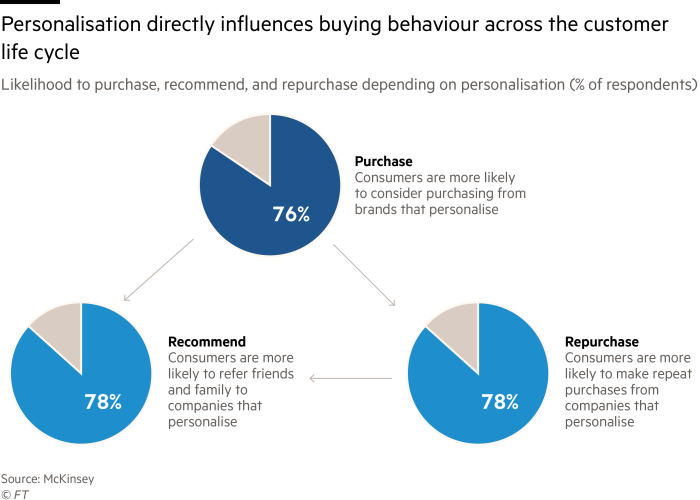
The different expectations of consumers and corporate customers
The relevance of a personalised approach goes beyond retail. While 73 per cent of consumers hoped “to be delighted” by a company, 87 per cent of business customers expected that too, according to research for software company Adobe.
Two-thirds of business customers envisaged the same or a better level of personalisation in their professional lives as they received with personal purchases.
More than half of those surveyed expected personalised content in all interactions, from researching a company’s products or services, to purchase, use and getting help. The pay-off is higher conversion, deeper engagement and fiercer loyalty, Adobe says.
This makes sense, Betteridge says. “[As a company] you’re in a very different position when you’re spending a million pounds versus a B2C customer who is spending a fiver,” he says.
“B2B customers are much more used to [someone working] with them as a partner, not just as a supplier.” He says that in such a relationship there is greater understanding and “they go the extra mile in terms of solving their problem”.
Companies must invest in a relationship with a corporate customer as fully as for a consumer, even though the switching costs for a business relationship can be higher.
On the consumer side a good connection is needed to stop people from switching, which in a world of choice is simple to do. As AI-amplified search makes finding rival products even easier, corporate survival will rely on customer loyalty. Personalisation and relationship-building will be vital.
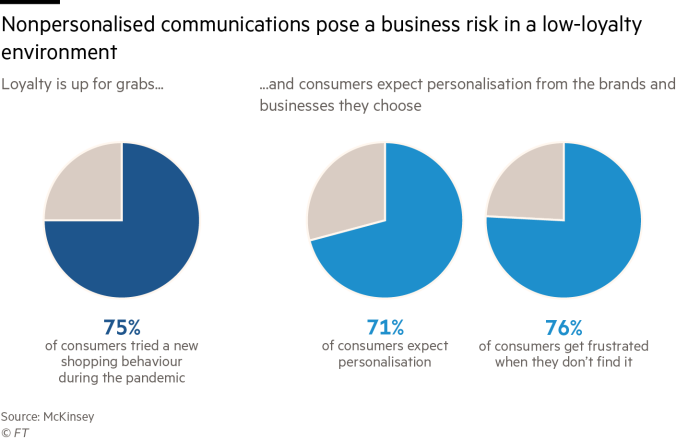
How to personalise: it’s not rocket science but getting it right is hard
Personalisation goes beyond putting a recipient’s name at the top of an email. It is now about anticipating customers’ needs and offering them the right product at the right time on their preferred channel.
Betteridge says: “It’s not rocket science. It is giving people what they want, in the way they want it, at the time they want it.” It may be easy to understand but getting it right is hard — as consumer feedback shows.
Seamless cross-channel marketing is vital if a company is to give a customer a good experience. The Sailthru Retail Personalisation Index scored 500 brands for their website, mobile, email and privacy performance. The best brands customised email campaigns using data such as purchases and browsing histories. A telling statistic is that 83 per cent of the top 100 performers did this compared with only 43 per cent of the also-rans.
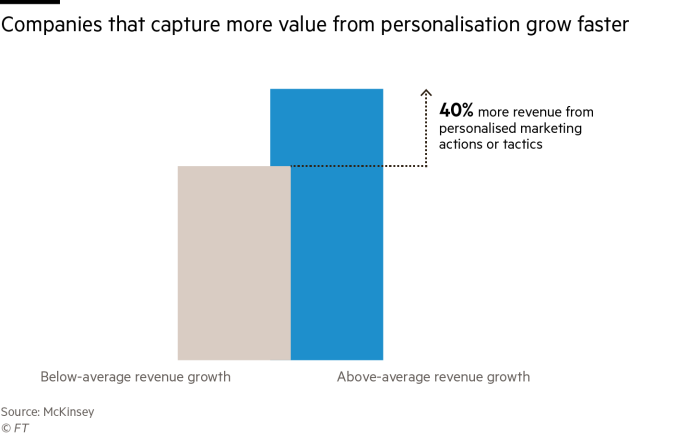
Segmentation still has its place
One way to anticipate what may appeal to a customer is to divide them into segments using, for instance, demographics or location, but this rudimentary approach is considered outdated. Narrowing down the segments is still insufficient, Deloitte says.
Segmentation is still valid but the approach has changed. “Most marketers will tell you they have a customer problem,” Taite says. “But we believe they have a ‘clustomer’ problem.
“By this we mean that they treat all of — or a bunch of — their customers in the same way.” This creates “a tangled mess”, she says. “They group together people with very different behaviours.”
Customers bundled by behavioural triggers might react similarly to emails sent at a certain time, or loyal customers could respond differently to a promotion than, say, a casual browser. More nuanced segmentation allows a greater variance of approaches to customer types.
“What we have now with AI and automation is many different types of segments,” Taite says. “We can resource and create for all those segments and all those customer journeys. [We can] make sure that everybody is receiving the right message at the right time with the right offering depending on their individual needs and behaviours.”
In effect today’s technology allows companies to deal with each customer as a segment of one, mapping their behaviour and purchase history from all points of contact. When these data are matched with real-time monitoring, companies can respond to consumer actions with timely messages or offers for products that may be of interest.
Algorithms that use machine learning can even anticipate when the customer is likely to visit a website and send them offers accordingly, or issue reminders about regularly purchased products when they might be due for a refill. Similar systems can also conduct wording and channel experiments — so-called A/B testing — to establish which approach elicits the best response.
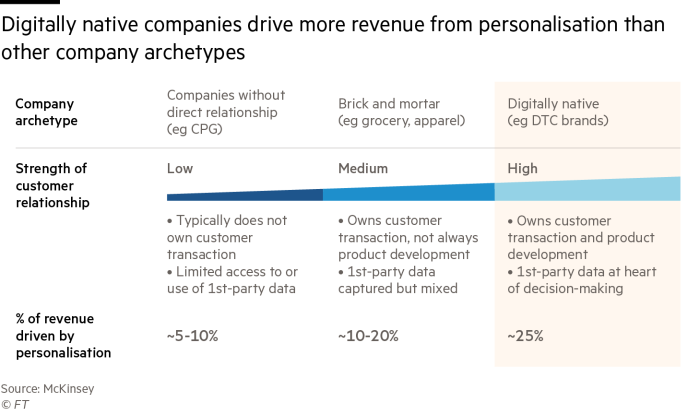
Content pooling can be done automatically
Forrester, the Massachusetts research company, says organised content creation, using content modules, is beneficial to personalisation at scale. The companies that do it best create modules that are tagged and placed in a repository for easy retrieval and reuse, ideally by an automated system.
Other Strategies
Loyalty programmes
Location based coupons
Emailed discount offers
Modular content can be put together on the fly to respond to a customer’s real-time activities or their anticipated next need. Communications should be co-ordinated across channels with the sequence of delivery orchestrated by AI and machine-learning technology. Messages drop on to the user’s laptop, tablet or phone with the timings modelled on an individual’s data.
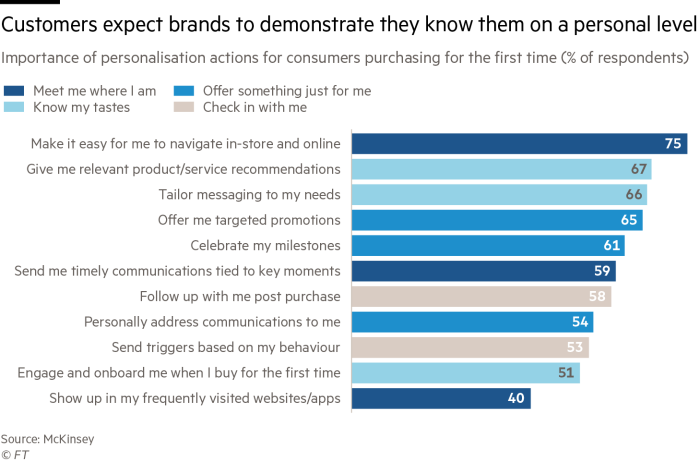
Go for quality over quantity with data collection
Although it is tempting to gather reams of data quickly, Betteridge says companies should not try to amass too much too early. The quality and relevance of data are key.
To build trust and encourage further information sharing, companies should show the value of this to the customer. For instance, clients who give their email addresses might receive an offer in the first email, while those who share their location could be invited to an event happening near to them.
There are several ways to collect information. Sign-on templates are a good starting point as these allow customers to choose the data they share. Thrive Market, the US grocery provider, asks new customers to identify dietary interests so it can offer products that match their needs. The Financial Times allows readers to customise their news feeds and put together a personalised homepage based on their interests.
Transaction and browsing histories, tracked through cookies, engagement with brand communications, social media interactions and feedback all add to the customer profile. Data purchase is also an option. In all instances companies should keep their objective in mind — whether that is fostering loyalty or improving conversion rates — and focus on collecting data that help to achieve their goals. It should always be remembered that quality is more important than quantity.
Gartner notes that consumers can be highly sensitive to some forms of data collection, which makes this risky to try. Questioning a customer on the number of children in a household, income, health and credit cards can provoke a negative reaction. In all cases, the data used must be relevant to what the consumer is doing or buying.
Brands that are transparent about what they collect and for what purpose, especially in terms of value for the consumer, will go further in winning trust. Personalisation designed to help a consumer, be it time-saving or a simpler purchase process, is favoured ahead of recognition.
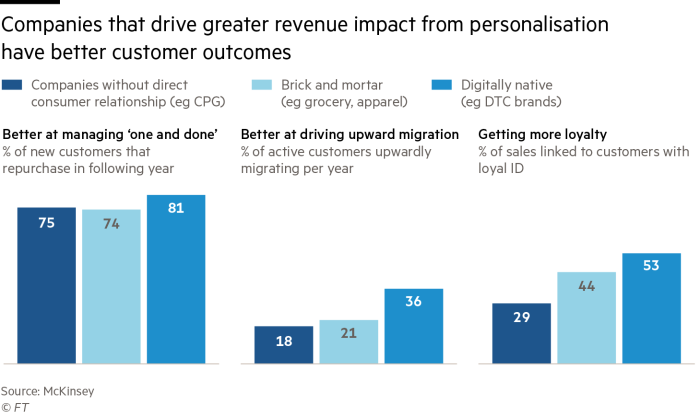
Do due diligence on the marketing company you choose
With the rapid development of generative AI and natural language processing, solutions to create and deliver marketing content have proliferated. Many of these use finely-tuned large language models (LLMs) to create marketing campaigns that use a brand’s “voice”.
Many companies will help marketers reach the consumer with personalised content across different (or all) channels. Businesses in this area include Intuit Mailchimp, Sailthru, Kentico, Insider, Wunderkind and Bloomreach.
Based on a company’s marketing objectives — be it selling a specific item, getting a consumer to complete a purchase, or cross-selling — these providers will gather and analyse data, experiment with messaging and find the best way to reach any one person. Ideally, that consumer’s actions are then converted into revenue.
Dan Head, chief executive of Phrasee, a marketing solutions provider, says the simple approach of putting “wrappers” around LLMs is not the best solution in an end to end marketing campaign. “If you conflate language generation with performance prediction you either get hallucinations or a lack of diversity, or both,” he says. While LLMs can create adequate content they fall short in knowing what might succeed.
Phrasee has developed a neural network to predict campaign performance. It uses nine years of machine learning based on click-through rates and other measures. By plugging this into LLMs or using its own logic content creator, Phrasee provides greater certainty that marketing will hit the mark. The next step will be to oversee the output of the LLMs to hone the quality of communications at scale.
For physical locations, facial recognition is also an option. Deloitte says one airline uses that technology to tell its staff about members entering a VIP lounge. People are greeted by name and given their favourite drink or offered services based on past visits.
While high-level segmentation may be outdated, more precise classification of customers based on behaviour, engagement and transactions can be useful. All that is possible using AI with natural language processing. Intuit Mailchimp has a tool that will allow a marketer to list, for instance, male customers who have bought a particular item in the past 30 days.
There is potential for even greater sophistication. As AI improves its empathy, marketing campaigns will be matched to consumers’ moods. With better natural language search, AI may soon search for solutions to a problem, rather than simply look for products.
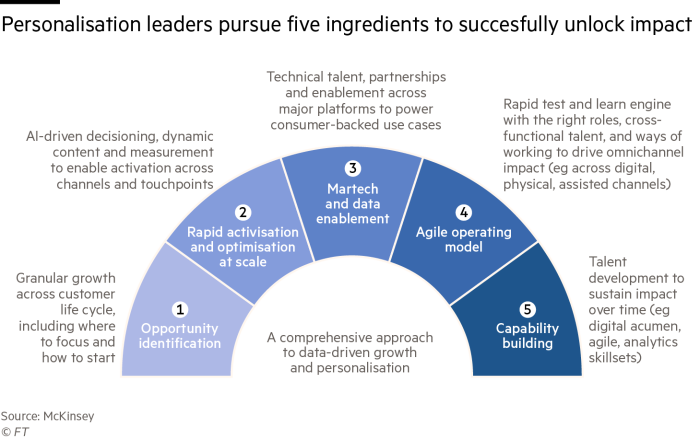
Retailers lead the pack while retail banking lags but has potential
The retail sector remains ahead of the pack in personalisation, with suppliers such as Amazon most adept at directly addressing the consumer. Entertainment also uses algorithms to improve customer engagement. Netflix, Spotify and TikTok all increase time spent on their platforms with the use of highly personalised recommendations.
The next step in personalisation is likely to be greater collaboration between consumers and brands, with consumers seeking input on creating their own products. This will be an evolution of the trend begun by YouTube and TikTok, where consumers make unique content.
Taite of Intuit Mailchimp says: “Gen Alpha represents the next group that has major purchasing power. They’re more likely to engage with brands that invite them to co-create and explore rather than sell. That’s where personalisation can play a key part.”
The financial sector still lags behind, especially retail banking, but the scope to offer greater insights and advice is huge. This will be based on customers’ behaviour as well as their financial ambitions.
Private wealth, which is already more dependent on a tailored service, is ahead of retail banking but can still be better.
Retaining the millennial client, in particular, relies on understanding their needs. Simon-Kucher, the marketing and strategy consultant, says that these future core customers “will give you only one chance” to deliver a high level of service, including customised recommendations and exclusive perks.
Digital offerings have improved since the pandemic but Silvio Struebi, partner and head of Apac banking at Simon-Kucher, says: “A lot of the needs we identified are more important than ever” as more services migrate online.
Do not upset the customer over privacy
How to manage the balance between privacy and personalisation?
“Delicately”, Taite says. “People want meaningful experiences but it’s really important for marketers to explore the ways to balance personalisation with privacy.” While AI provides an opportunity to give customers a good experience, she stresses the importance of responsible use, trust and transparency.
“Ultimately personalisation isn’t possible without data. Companies must use it in a way that is so transparent that customers understand what they give their data for,” Taite says. “Three out of four customers are comfortable with companies using their data if they are transparent over how they use it. Then it’s about providing the value.”
A study by the Harvard Business Review draws a distinction between first-person and third-party sharing. People may be comfortable with giving their information directly but are less keen if details are passed on without their knowledge. This is as true online as it is off.
Information used to deploy target ads obtained from sources other than a trader’s own website can make consumers uncomfortable. The same goes for trying to deduce people’s circumstances from analytics. They are then less likely to make a purchase.
Transparency regarding the collection of data, customer control over how much data is shared and the justification in terms of value to the consumer are vital to fostering trust and acceptance.
Regulation is split on the matter. The EU is keen on privacy, having been the first bloc to implement data protection rules. Meta, the parent company of Facebook and Instagram, was fined nearly €400mn in January for in effect forcing users to share their data for targeted advertising. Perhaps Meta was more accustomed to the US market, which is less regulated and where businesses can harvest and use data at will.
Informed consent is the ideal situation but privacy advocates complain that too many websites make opting out of cookies too convoluted. From a consumer’s perspective, opt-ins would be fairer and more direct.
A more consumer-oriented approach is inevitable. Head, of Phrasee, says that it is already easier for consumers to opt out of sharing data, and this puts pressure on companies to “earn the right” to reach them.
Even if many companies would prefer to take advantage of automatic opt-ins, brands should stay on the right side of consumers by being transparent about what they gather and how it will be used, as well as providing choices about what is shared.
Those companies that implement good practice before regulation is applied will be in a stronger position to cope with any changes.
Three important takeaways
Always consider the desired outcome for your company as the first step. This defines what data you need. Do due diligence with any tech provider. Ensure that its service will achieve your objective.
It is worth noting that the more data companies gather, particularly sensitive information, the more seriously they must take data breaches and cyber security.
Have a plan that shows how personalisation will help you to achieve your goals. Be sure to understand the customer and work from their perspective. That way you will win consumer trust and loyalty.
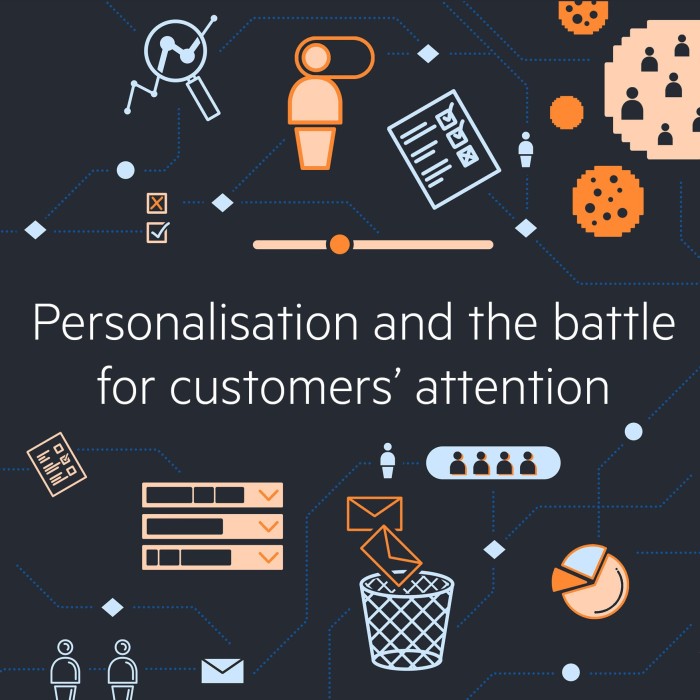

Comments